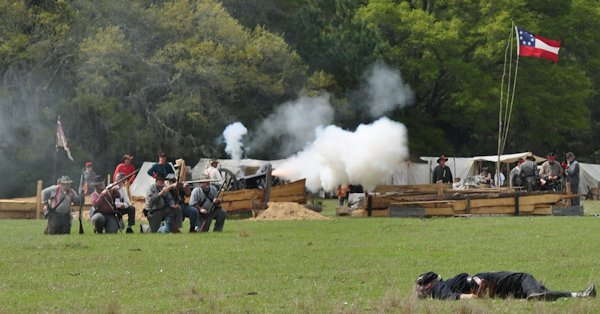
Public Event at Legare Farms – Annual Civil War Reenactment
Editor, The Post and Courier
letters@postandcourier.com
An article in Sunday’s issue raised the question of using County Rural Greenbelt funds for conservation easements on private land as opposed to purchasing land, known as “fee simple†funding. The article also addressed the issue of public access on Greenbelt funded properties. The Johns Island Conservancy has done a detailed analysis of the 80 rural projects funded so far using the data from the Greenbelt Bank’s website (www.smallchangeforbigchange.org).
The article implied that purchased land allows public access and private easements do not. That is not the case. While almost 100% of the fee simple purchases will allow some future public access, only 44% of the dollars already spent was for projects that have already been opened and 60% of those allow only limited access. By contrast, approximately 12% of the conservation easement funding allows some public access. The Legare Farm, easement will allow limited public access.
Public access for recreational and educational opportunities is not the only public good served by Rural Greenbelt investments. Some of the other common objectives of a greenbelt program are:
- · Protect natural environments and wildlife;
- · Improve air and water quality;
- · Protect the unique character of rural communities.
In deciding the use Greenbelt funds we believe the County Council should consider and balance all these objectives. They should consider the financial value the public gets for each dollar spent. That value is determined by the cost per acre of land preserved and the matching funds by other organizations and individuals.
So far about 70% of the Greenbelt money spent has been on projects that allow public access. Only 30% has been spent on conservation easements that meet the other objectives of a greenbelt program. The Greenbelt cost per acre of public access property has been $13,081, the cost per acre of property that meets the other objectives has been $1,622; about 8 times greater dollar value per acre. The matching funds for projects that allow public access has been about dollar for dollar; matching funds for conservation easements has been about three to one. Surely these dollar amounts should be considered when reviewing the value of each of the greenbelt objectives.
The Legare Farms project will allow limited public access and includes an almost 2 to 1 matching value. The Greenbelt cost per acre for the conservation easement on this property is $3,000. That is greater than other properties but well within the “value†of properties that allow limited access. In addition, the property is on the border of the urban growth boundary in a rising real estate market adding to both its cost and value. It will serve the greenbelt objectives of a larger and closer population than other easement projects.
The final paragraphs of the article address some other issues concerning the property owner, the Legare family, and specifically Thomas Legare. Elizabeth Hagood said it best before the Council two weeks ago, “it’s about the land, not the landownerâ€.
One council member feels that Legare is not likely to sell to a developer so why spend money to protect it? That is simply wrong. They will sell. At some point in the near future, the difference between the agricultural value of the property and the development value will become so great that the Legare’s or subsequent landowners will build, 300, 500 or 1,000 homes. If a developer gets hold of the property, what chance will there be for any public access? This conservation easement will permanently prevent that, preserve the property for the benefit of all the residents of Charleston County and provide the opportunity for limited public access.
Colin Cuskley
Executive Director
Johns Island Conservancy
Click here to see our analysis of “fee simple” versus conservation easements and public access.

 Johns Island Conservation Easement
Johns Island Conservation Easement
Please save this beautiful piece of property.
Thank You in Advance
Louis Dallara
The Legare family history on Johns Island goes back 9 generations to the early settlement of the lowcountry.
This season of growth is short, and comes with great cost. Please do not rob our children of their heritage and their future. Housing developments built today will be low income housing for your children’s children. Farms will be wealth without value in our planet’s future.
The people of our government have a burden to place no more hardship on the early settlers of our land. First, we drove off the true natives, now we disregard the rights and privileges of the closest thing we newcomers to this world have to natives. These are the lands of our ancestors, of our founding fathers. Let us do everything in our power to preserve them before all of our short history is lost to the greed and short-term desires of people who were elsewhere yesterday, and will be gone tomorrow.
The Lowcountry Open Land Trust (LOLT) has applied for Charleston County Greenbelt funds to help finance a conservation easement forLegare Farms on Johns Island. Last month, the Greenbelt Bank Board unanimously recommended these funds be allocated. Last week the County Council Finance Committee, in an unusual move, rejected the recommendation of their own Greenbelt Board.
I support the allocation of Greenbelt funds to help finance a Lowcountry Open Land Trust conservation easement on Legare Farms on John Island and would like an answer as to why this recommendation was rejected by Charleston County Council.
I urge the full council to reconsider last week’s Finance Committee decision and add the issue to this week’s Council agenda. I support at least returning the application to committee for further due consideration at next month’s meetings.
Thank You
I ask that this matter be given every possible consideration for the benefit of the Johns Island greater community. Thank you.
Please reconsider your votes on this issue. There family is a part of the community and regularly gives back. They have not restricted access.